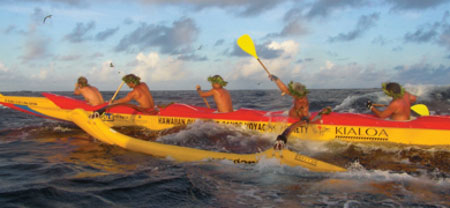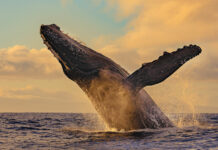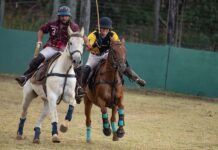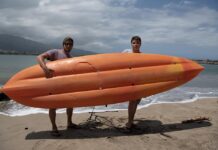Jason Hilford | Onboard photography by Michael Gilbert | Wildlife photography by David Liittschwager and Susan Middleton
The canoe weaves in and out, up and over the sun-speckled crests,
the paddles in constant, harmonious motion, every stroke a chanted phrase,
a story older and more powerful than recorded history.
With each minute, each hour, we stay our northwest course,
the primeval narrative unfolds toward an objective, an ending,
simultaneously geographical and intangible. . . . Northwest.
In the waters of Na Mokupuni na Kupuna, we are time traveling,
following the path of the ancients.
 Sparks fly as First Mate Paka Cunningham welds a metal cleat into place on the stern of the American Islander, docked in Kaua‘i’s Nawiliwili Harbor. The deck is abuzz with activity in the waning sunlight as Captain Matt Tongg’s crew and the soon-to-be passengers on this 97-foot tug prepare for the open seas. Canoe paddles and other supplies are transferred from dock to deck; five-gallon water bottles are passed, bucket-brigade style, down the hatch into dry storage. It occurs to me that the Hawaiian language uses the same word for “boat” and “island”: moku—for the next 10 days, the American Islander will be our moku, our floating island, as we travel through the most isolated chain of islands in the world.
Sparks fly as First Mate Paka Cunningham welds a metal cleat into place on the stern of the American Islander, docked in Kaua‘i’s Nawiliwili Harbor. The deck is abuzz with activity in the waning sunlight as Captain Matt Tongg’s crew and the soon-to-be passengers on this 97-foot tug prepare for the open seas. Canoe paddles and other supplies are transferred from dock to deck; five-gallon water bottles are passed, bucket-brigade style, down the hatch into dry storage. It occurs to me that the Hawaiian language uses the same word for “boat” and “island”: moku—for the next 10 days, the American Islander will be our moku, our floating island, as we travel through the most isolated chain of islands in the world.
Most people are unaware of the chain of seamounts, atolls, and islets stretching 1,200 miles beyond Kaua‘i, occupying about two-thirds of Hawai‘i’s area (but only one-tenth of one percent of its total land mass), larger in area than all of our national parks combined. Known communally as the Northwest Hawaiian Islands (in Hawaiian, Na Mokupuni na Kupuna, or the Islands of the Ancestors), these tiny rocks and sand banks barely piercing the surface, along with the surrounding waters, are home to 7,000 marine species and 14 million birds (including the Laysan duck, one of the world’s rarest ducks, include 70 percent of the nation’s coral reefs, and serve as the nesting ground for 90 percent of the state’s green sea turtles. So remote that it occupies a different time zone from the rest of the state, this corner of the Pacific received Federal recognition last summer as the nation’s first marine national monument, and the Hawaiian Outrigger Canoe Voyaging Society and support crew are honored to be among the area’s first visitors since it gained monument status.
Alongside Paka sit both an inflatable rubber zodiac with a small outboard motor and the bright yellow hull of Ke Alaka‘i o Ko‘u Mau Kupuna, a 40-foot Hawaiian outrigger canoe. In a few days, the 15 men and one woman representing the society will paddle the 461 miles between Necker (Hawaiian name: Mokumanamana) and Laysan (Kauo) Islands. The society is a nonprofit organization forged in the vision of one man, Maui’s Kimokeo Kapahulehua and his dream to connect all of the Hawaiian Islands, from Hawai‘i Island to Kure Atoll, by outrigger canoe. A group of paddlers who share his vision and form the core of the society—Jamie Woodburn, Chris Luedi, Matt Muirhead, Kendall Struxness, and Pepe Trask—has helped Kimokeo realize that dream thus far, starting with a 2003 journey from Hawai‘i Island to Maui. (All but Trask are along on this journey to Laysan.) This penultimate leg (the ultimate being next year’s trip to Kure) will be the longest yet, the longest paddle-canoe voyage in modern history, in fact, and the society has dedicated it to creating awareness for the monument and its preservation. As the lone journalist onboard, I am charged with the seemingly impossible assignment of documenting this epic voyage.
Hours later, the tug is moving slowly through the darkness toward the red and green lights marking the harbor entrance. I stand on the bow with a handful of paddlers as we pass those lights, and the spray of open-ocean swells immediately begins to cascade over us. After about 36 hours of motoring to the northwest, we will reach Necker, where last year’s group completed their 190-mile journey from Nihoa Island.
The breeze on deck is almost chilly as we approach Necker. Even before sighting land, we know we’re nearing an island when the sky fills with birds: terns, boobies, and petrels. Then the island appears, looming on the horizon in the early-morning sun.
While Nihoa’s natural harbor, palms, and native grasses provide an inviting foil to its angular 600-foot cliffs and peaks, Necker is all stone and guano, a self-contained bird refuge—16 species of seabirds, numbering 60,000 individuals, nest on this stark ridge rising 277 feet above the ocean’s surface.
Kimokeo, somber and reverential, passes out head and neck lei, and we don them like warriors. As they will do with each island we pass, Kimokeo and a select few paddlers each say a brief prayer and drop a pohaku (lava stone) into the sea—a traditional gesture bringing with it the mana (power) of the ‘aina (land). We surround the canoe on the deck as he circles it, carrying a bowl of ‘awa (kava), sprinkling the canoe in blessing, and chanting in the language of his ancestors, his eyes smiling. The ceremony is especially powerful at Necker, a Hawaiian cultural and religious hub with an astounding 52 archeologically significant sites.
Captain Matt has shut of the engines, and the tug glides silently to a stop. We guide the canoe, and then the zodiac, into the ocean. The first team of six jump into the deepest water imaginable and climb into the canoe. Within a minute, they are all settled and paddling; we watch in awe as they careen around the swells, Necker in the background, sunlight playing off the crests and blending with the canoe’s bright-yellow hull. A small Hawaiian flag flutters in the wind from a pole fixed to the canoe’s stern. I can see the paddlers’ grins from 100 yards away, and the movement of their arms is fluid, natural, and vigorous. The paddles move in unison like turbine blades, the well-oiled parts of an efficient machine, blades breaking the water, easing backward below the water’s surface, rising in the air, breaking the water, all within seconds . . . six individual members of a united team, many of whom have just met on this moku, joined seamlessly, an ‘ohana (family) with a common course: straight on ‘til Friday.
I finally begin to comprehend how the team rotations will work. Every hour, the group paddling the canoe will rotate with the team resting on the tug. Both teams consist of eight members, and since this is a six-man canoe, two members of the team currently paddling will also be resting on the tug.
For each individual paddler, this means one hour on, one hour off throughout the day, with a designated three-hour nap break every eight hours. Unless replaced by an alternate paddler before or after this long break, nobody will get more than two-and-a-half consecutive hours of sleep day or night, so long as the canoe is in the water.
The first few hours of paddling present an array of puzzles for the crew, most of which have to do with the canoe shift changes. Effecting these changes involves an elaborate set of steps; avoiding serious injury (or worse) requires paddlers and the tug’s crew alike to perform each of these steps flawlessly. I soon discover that I have been enlisted, along with fellow alternate paddler Josh Circle-Woodburn, as an ad hoc deckhand for the changes—keepers of the 60-foot line attached to the zodiac’s bow. Grant, the boat’s wiry South African cook, shows us the ropes, so to speak, at about two in the afternoon.
I’m told that last year, the changes were the most critical parts of the paddle, and I can see why: One slip, and you’re overboard between two rocking, bumping boats on the open ocean. Depending on swell heights and timing, the vertical difference between the zodiac and the jumping-off point on the tug’s gunnel can range from practically level to 10 feet, all within seconds. The engines, which tend to suck in water (and anything that happens to be in it), grind menacingly just below us at the corners of the stern. As the canoe voyage progresses, over 460 miles of ocean, for 80-something hours (and an equal number of changes), fatigue will set in, making everyone less and less sure of their steps. It will be in this capacity that the group’s toughness and determination will truly reveal itself: Ryn Hughes, a blond Texan-turned-Mauian—the only woman on the boat, who will become my most valuable paddling teacher—and her unbelievably calm demeanor in climbing from tug to zodiac, zodiac to tug. Jamie Woodburn—the man whose determination in securing the entry permit has allowed us to be here—and his quiet grit, making every motion look easy. Wailuku realtor Mike Spalding, who constantly wears a smile on his face, even in the most adverse conditions. Swiss-born Fairmont Kea Lani General Manager Chris Luedi, an intense, yet affable, Maui transplant whose efficient movements epitomize his countrymen’s well-known industriousness . . . beyond a few slips and scrapes, they’ll find a way to weather these onerous, albeit self-imposed, conditions unscathed.
It’s been easy to yell orders down to the paddlers as I pull the rope and they jump in and out of the zodiac. Now that I am about to become one of them, I can see the difficulty of their undertaking as I watch the rubber boat lurch and slam into the side of the tug. I knew I’d be an alternate on the canoe. What I didn’t know was that I’d see my first paddling time—only my second time ever in an outrigger canoe—in the middle of the night.
One by one, we leap overboard like paratroopers into a war zone. By now, I’ve watched everyone perform this task, and I feel like I’m getting to know all of them as individuals simply through their idiosyncratic methods of carrying it out. Matt Muirhead, a Kaua‘i-born agricultural risk assessor in Santa Cruz, California, prefers the gravity method—barreling lemming-like over the gunnel and slamming comically onto the floor of the zodiac. My favorite, though, is Kama Hann, a 60-year-old retired high-school teacher from Moloka‘i—and full-blooded Hawaiian—who always times the swells perfectly and steps gingerly across.
Nevertheless, I will learn tonight that the lemming approach works best for me; I’m the last of the six in the zodiac, and as I plummet, Kimokeo is already catching the stern line. We drift away as the tug starts its engines, and within moments we’re literally at the end of our rope. The canoe appears, as if out of nowhere, its flagpole now crowned with a small locator light, and we begin the transfer, starting with seat one. Seat five vacates, and I find myself attempting to clamber from one small bobbing object to another.
It’s four, or five, or three in the morning—I really have no idea—and I’m sitting completely still in the absolute middle of the ocean, with five other equally silent people, in a 40-foot canoe. The moon may be full, and the crests of the six-foot swells passing under us may be glowing hypnotically, but it’s still a big, dark ocean, and it looks even bigger and darker at night. The lights of the tug buck and toss on the same swells, fewer than 50 yards ahead of us, and that 97-foot boat looks small!
The job of steering the canoe suits Kimokeo: Part captain, part surfer, the steersman guides the canoe into swells with his paddle, unifying the team and making sure the precariously narrow canoe stays upright. In the darkness, he calls for us to begin paddling. Following seat one’s rhythmic lead, we dip our paddles into the blackness as one. I am now one of those turbines I saw from the tug.
Kimokeo guides us around crests, into troughs. We ride swell after swell, gaining and losing speed but keeping momentum, the only sound the plash of paddle. The canoe zigzags along, finding the path of least resistance. I think about the navigators whose path we follow—Kimokeo’s and Kama’s ancestors, who, minus the fully equipped escort boat, the GPS, the charts and maps, struck out for the horizon, toward these tiny islands out of oral folklore. I know Kimokeo feels those navigators here with him, their mana, and somehow I know we all feel it as well, how we are traveling at exactly the right moment in history, guided by the kupuna (elders) and kapena (boat captains) who were consulted both spiritually and practically for the exact time of year to make the trip; how we are rolling along with the wind and the swells during a full moon in August, a month of few storms. My paddling form is atrocious; my paddle slams the gunnels (a big no-no), and I keep splashing myself and poor Chris Luedi in seat four . . . but when the tug whistle blows at 10 ‘til whenever, I can’t believe an hour has already passed.
Maybe it’s a trick of my imagination or my $10 polarized sunglasses, but ocean water of this depth has a tint of deep blue I’ve never seen anywhere else in nature. I periodically walk up to the top deck just to look around at the expanse of water surrounding us in all directions.
After almost three full days of paddling, fatigue has really begun to show. Aching paddlers sprawl across the carpet padding the upper deck, their arms and legs splayed every which way. I try to envisage the pain they must be feeling, pulling themselves up delicately whenever that whistle blows, pushing that canoe along hour after hour.
Still, the canoe keeps moving, keeps slaloming the swells and ripples, paddles rotating less and less in-step as fatigue becomes ever more of a factor. In my many waking hours, I stand on the stern every hour at a quarter ‘til, waiting in the wings for the whistle so I can pull the zodiac bow rope the second the engines churn in reverse. The teams move into and out of the rubber boat like the tide, emptying and filling the canoe seats, fighting the soreness.
As the sun approaches the horizon today, it’s again my turn to get in the canoe. Each time I paddle is a new learning experience, a new chance to try out the host of pointers I’ve solicited from my boatmates. Yesterday, Ryn showed me how to bend at the hips and use my back muscles to pull the blade through the water, and Terry Quisenberry—a 50-something fencebuilder from Ha‘iku —taught me that the uniform timing I’ve been admiring is the single most important factor; paddles hitting the water haphazardly can slow the boat or even cause it to turn over.
Another brilliant sunset, and I’m in the canoe. Kihei architect George Rixey is sitting in seat one, setting the paddling cadence. He sets a methodical pace, and the rest of us follow suit—and I again feel the sensation of building energy, of connectedness.
It’s obvious everyone else feels it too; compliments for George’s pace fly around generously, and we paddle as one. Mike Spalding steers us gracefully into swells, smoothly riding the current. Perfectly unified paddling feels almost effortless—the paddles dip together into the already-moving water beside the boat, a perpetual stream.
The whistle blows, and we congratulate each other on a simply unbelievable run. We have tapped into something big here, and all six of us are riding an uncanny emotional wave; I can see it in the wide grins in the zodiac—it’s a sensation I already recognize as one of a handful of outside observers. “Every time we had a change,” Captain Matt will tell me later,
“The guys coming into the canoe were exhausted. By the time they got out, they’d be pumped up and excited.”
An hour later, I stand on the stern alone for moonrise, its luminous whiteness ascending, lighting up the sky and the previously black ocean. Another change, and I pull in Kimokeo’s team. As always, he is the last one on the tug; I guide the stern line to the gunnel, and he steps calmly onto the deck.
“Did you have a good run, Kimokeo?” I ask.
“I always have a good run, Jason,” he replies, his face almost mystically alight. He tells me about Pele’s children—the waves, birds, turtles, monk seals, moon and stars, tide and current. We’re in their hale (house) and are blessed with their permission to be here, and their guidance and assistance on our journey. He is still beaming as he walks toward the cabin.
We had to pull the canoe and zodiac on board for a few hours last night for a safety rest stop. Even with the onboard crane, dragging those boats onto the deck in heavy surf at midnight was a trying enterprise that nonetheless afforded everyone a few precious hours’ sleep.
I turn over in my bunk, and the Gardner Pinnacles greet me, three miles to the starboard side, through my personal porthole. Lying 117 miles west of the French Frigate Shoals, which we passed during the night, the rounded basalt Pinnacles tower like a giant ice-cream sundae crowned with a healthy topping of white guano. According to my reference book, this is the least-visited of the Northwest Islands. My first thought parallels my late grandfather’s when he found himself in New Zealand facing a sign saying he was closer to the South Pole than the equator: “I’m a long way from home.”
On the morning following the safety stop, with Gardner Pinnacles in the background, the paddlers begin the painstaking process of relaunching the canoe and zodiac.
I tried—I really did—to stay up for the end of the voyage, but at four in the morning I lost my battle with sleep. When I woke this morning to the sound of boisterous chatter in the galley, I knew we were there. Laysan Island—the name floated around mirage-like all week, the prize for the inconceivable feat we have now, apparently, accomplished.
I shovel down a quick bite and head out to the deck, where a congregation has formed on the port-side rail. And there it is: Laysan Island, a mile-and-a- half dollop of sand and palms in a placid, turquoise ocean. The canoe is already out of sight, exploring the shores of this forbidden place.
Our permit to enter monument waters explicitly forbids the tug from approaching within three miles of any of the islands, and we are not about to violate it. Easing the tug to a stop, Captain Matt radios to the island, to the four NOAA researchers living there seasonally. They respond, wondering who we are and what we are doing; when he tells them, they react with utter shock. In the tradition of his ancestors, Kimokeo has instructed the captain to offer them ho‘okupu, gifts from the visiting voyagers. They accept and invite us to approach the island; they are ecstatic to hear about the yogurt and ice cream, and a little lukewarm about the Gatorade.
We know nobody will be allowed to set foot on the island; Jean-Michel Cousteau was here recently and had to freeze his clothes to avoid endangering the island’s fragile ecosystem by inadvertently introducing invasive insects or seeds.
We load the ho‘okupu into the zodiac, where Captain Matt and three others are ready to go. Standing on the stern looking down at them, I realize I have a golden opportunity: there is one seat left. “Got room for one more?” I call down. Captain Matt nods somewhat reluctantly, and within a millisecond, I’ve entered the most remote ocean water in the world with a spectacular belly-flop. A few seconds later, I’m onboard the zodiac, and we’re buzzing toward the island. The canoe, which has since returned to the tug, follows at a distance.
The water at Landing Cove on the island’s west side is indescribably beautiful—a translucent turquoise I used to think was reserved for overly romanticized paintings. We approach the island’s sandy shore, fringed with palms and sprinkled with sunning monk seals. This is the desert island everyone dreams about, complete with a lake in the middle.
Four 20-somethings—two men and two women—wait for us on the beach, and all I can think about is how small these researchers look, out on their own for months in the middle of the ocean. They wade out to meet us in waist-deep water, allowing us to obey our permit, which forbids landfall. Alongside us, the canoe, filled with six beaming, shirtless men, heads and necks adorned with lei, is a snapshot out of history. Time slows to a crawl as Kimokeo stands up in the steersman’s seat, blows the pu, (conch shell) and in his proud baritone chants, “Liu liu i ka ho la le,” asking permission to approach the island—it is the most haunting melody I’ve ever heard.
We crowd around the researchers in the water as Kimokeo presents the ho‘okupu and greets each of the four with ka lei i mai la—a lei presentation chant—and a bear hug, crowning each with one of the four head lei around his arm. Two of the researchers are crying. I reach down and grab a handful of sand, which is actually a collection of huge chunks of coral, bleached bright white in the sun. I look up again at the painfully powerful scene ahead of me; colors are strikingly potent, and every sound is a song. As tradition dictates, the scientists have given us a number of glass fishing floats as return gifts. Two days from now, I will be rendered speechless when the voyaging society’s board presents one of them to me.
The emotional gathering is soon over; we say our goodbyes and strike out for the tug. The canoe is ahead of us this time, surrounded by curious seabirds, and a rainbow appears overhead. It is just one of the many salutations the hale o ke kai, the house of the ocean, has granted us: the dolphins and porpoises that seemed to appear each time we conducted a ceremony offshore of a new island, and the albatross that flies over us as we say goodbye to Laysan. Just before we leave, First Mate Paka opens the tiny urn he has worn tied around his neck for a year, and drops a small amount of his departed friend’s ashes into the ocean.
The tug turns around, rather unceremoniously, I think, and heads southwest. We have three days of motoring ahead of us—this time into the current, wind, and swells. Time will again have meaning—night and day, communal meals, and real nights’ sleep. We’ll have time to reflect on this extraordinary accomplishment, this extraordinary place, before pulling back into our new home port, Nawiliwili. The echo of the pu as we enter protected waters will linger in my memory, and I will think about my 10 days at sea with an inspiring group of people, joined in this common purpose.





